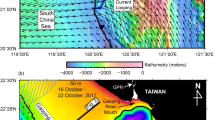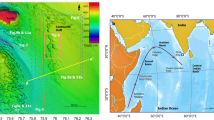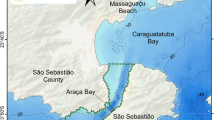Abstract
A study utilizing a dense grid of seismic and piston-core data revealed that four different types of sediment wave fields have formed on the northern slope of the strongly enclosed and low-latitude marginal South China Sea (SCS). Their origins include turbidite flow, bottom current, gravity-induced deformation, and multi-origin. Three sediment wave fields formed by turbidite flow are neighboring to the channel or canyon, have the up-current migration and decreased size from a shallow depth to deeper water, have greater content of sand and decrease of grain size from upslope to downslope, and a lower content of CaCO3. Bottom current’s sediment wave fields are parallel to the slope, with small-size erosive troughs, scours or furrows, and convex depositional system on the downslope of the erosive field, and with a lower content of sand, a finer grain size, and a greater content of CaCO3. Gravity deformation’s sediment wave fields are adjacent to the canyon, and develop several sliding surfaces corresponding to wave troughs, wave variation of no regularity. One sediment wave field was more symmetrical, displayed a smooth and rounded morphology, and has not evident migration direction, which is the result of the interaction of turbidite flows and bottom currents. Every sediment wave field involves a complex interaction between geomorphology, tectonic setting of neighboring area, and oceanography of the SCS. This study assists us to understand deeply the sedimentation processes and correspondingly depositional system in the deep-water with strongly enclosed and low-latitude characteristics and analyze the context and propagation direction of the arc-continent between the Eurasian Continent and the Luzon Arc.










Similar content being viewed by others
References
Alexandre N, Calvin CD, Cartigny MJB (2019) The influence of turbidity currents and contour currents on the distribution of deep-water sediment waves offshore eastern Canada. Sedimentology 66(5):1746–1767
Baldwin KE, Mountain GS, Rosenthal Y (2017) Sediment waves in the Caroline Basin suggest evidence for Miocene shifts in bottom water flow in the western equatorial Pacific. Mar Geol 417:194–202
Berndt C, Cattaneo A, Szuman M, Trincardi F, Masson D (2006) Sedimentary structures offshore Ortona, Adriatic Sea—deformation or sediment waves? Mar Geol 234:261–270
Casalbore D, Romagnoli C, Bosman A, Chiocci FL (2014) Large-scale seafloor waveforms on the flanks of insular volcanoes (Aeolian Archipelago, Italy), with inferences about their origin. Mar Geol 355:318–329
Casalbore D, Falcini F, Martorelli E, Morelli E, Bosman A, Calarco M, Chiocci FL (2018) Characterization of overbanking features on the lower reach of the Gioia-Mesima canyon-channel system (southern Tyrrhenian Sea) through integration of morpho-stratigraphic data and physical modelling. Prog Oceanogr 169:66–78
Casalbore D, Clare MA, Pope EL, Quartau R, Bosman A, Chiocci FL et al (2020) Bedforms on the submarine flanks of insular volcanoes: new insights gained from high resolution seafloor surveys. Sedimentology.
Cattaneo A, Correggiari A, Marsset T, Thomas Y, Marsset B, Trincardi F (2004) Seafloor undulation pattern on the Adriatic shelf and comparison to deep-water sediment waves. Mar Geol 213:121–148
Centurioni LR, Niiler PP, Lee DK (2004) Observations of inflow of Philippine Sea surface water into the South China Sea through the Luzon Strait. J Phys Oceanogr 34:113–121
Chang YT, Hsu WL, Tai JH, Tang TY, Chang MH, Chao SY (2010) Cold deep water in the South China Sea. J Oceanogr 66:183–190
Chen H, Zhan W, Li L, Wen M (2017) Occurrence of submarine canyons, sediment waves and mass movements along the northern continental slope of the South China Sea. J Earth Syst Sci 126(5):73. https://doi.org/10.1007/s12040-017-0844-9
Damuth JE (1979) Migrating sediment waves created by turbidity currents in the northern South China Basin. Geology 7:520–523
Davies R, Cartwright J, Pike J, Line C (2001) Early Oligocene initiation of North Atlantic Deep Water formation. Nature 410:917–920
Droghei R, Falcini F, Casalbore D, Martorelli E, Mosetti R, Sannino G, Chiocci FL (2016) The role of Internal Solitary Waves on deep-water sedimentary processes: the case of up-slope migrating sediment waves off the Messina Strait. Sci Rep 6:36376
Ercilla G, Alonso B, Wynn RB, Baraza J (2002a) Turbidity current sediment waves on irregular slopes: observations from the Orinoco sediment-wave field. Mar Geol 192:171–187
Ercilla G, Wynn RB, Alonso B, Baraza J (2002b) Initiation and evolution of turbidity current sediment waves in the Magdalena turbidite system. Mar Geol 192:153–169
Ercilla G, Juan C, Perianez R, Abril BA, Estrada F, Casas D, Vázquez JT, d’Acremont E, Gorini C, Valencia J (2019) Influence of alongslope processes on modern turbidite systems and canyons in the Alboran Sea (southwestern Mediterranean). Deep-sea Res PT I 144:1–16
Faugéres JC, Stow DAV (1993) Bottom-current controlled sedimentation: a synthesis of the contourite problem. Sediment Geol 82:287–297
Faugères JC, Stow DAV, Imbert P, Viana A (1999) Seismic features diagnostic of contourite drifts. Mar Geol 162:1–38
Faugères JC, Gonthier E, Mulder T, Kenyon N, Cirac P, Griboulard R, Bernè S, Lesuavé R (2002) Multi-process generated sediment waves on the Landes Plateau (Bay of Biscay, North Atlantic). Mar Geol 182:279–302
Fildani A, Normark WR, Kostic S, Parker G (2006) Channel formation by flow stripping: Large-scale scour features along the Monterey East Channel and their relation to sediment waves. Sedimentology 53(6):1265–1287
Gardner JV, Prior DB, Field ME (1999) Humboldt slide: a large shear-dominated retrogressive slope failure. Mar Geol 154:323–338
Gong C, Wang Y, Peng X (2012) Sediment waves on the South China Sea Slope off southwestern Taiwan: implications for the intrusion of the Northern Pacific Deep Water into the South China Sea. Mar Pet Geol 32(1):95–109
Guan BX (1978) The warm current in the South China Sea. Oceanologia et Limnologia Sinica 9:117–127 (in Chinese)
Habgood EL, Kenyon NH, Masson DG, Akhmetzhanov A, Weaver PPE, Gardner J, Mulder T (2003) Deep-water sediment wave fields, bottom current sand channels and gravity flow channel-lobe systems: Gulf of Cadiz, NE Atlantic. Sedimentology 50:483–510
Ho CS (1988) An introduction to the geology of Taiwan: explanatory text for geologic map of Taiwan. Republic of China, Taipei, Taiwan, Ministry of Economic Affairs, 192p
Howe JA (1996) Turbidite and Contourite sediment waves in the northern Rockall Trough, North Atlantic Ocean. Sedimentology 43:219–234
Huang CY, Lin CW, Wang TK, Chang CP, Yuan PB (2000) Geodynamic processes of Taiwan arc–continent collision and comparison with analogs in Timor, Papua New Guinea, Urals and Corsica. Tectonophysics 325:1–21
Jallet L, Giresse P (2005) Construction of the Pyreneo-Languedocian Sedimentary Ridge and associated sediment waves in the deep western Gulf of Lions (Western Mediterranean). Mar Pet Geol 22:865–888
Jorry SJ, Isabelle J, Emmanuel L, Ricardo SJ, Savoye B (2011) Turbiditic levee deposition in response to climate changes: the Var Sedimentary Ridge (Ligurian Sea). Mar Geol 279(1–4):148–161
Kenyon NH, Belderson RH, Stride AH (1978) Channels, canyons and slump folds on the continental slope between South-West Ireland and Spain. Oceanol Acta 1:369–380
Khripounoff A, Vangriesheim A, Babonneau N, Crassous P, Dennielou B, Savoye B (2003) Direct observation of intense turbidity current activity in the Zaire submarine valley at 4000 m water depth. Mar Geol 194:151–158
Klauckea I, Massona DG, Kenyona NH, Gardner JV (2004) Sedimentary processes of the lower Monterey Fan channel and channel-mouth lobe. Mar Geol 206:181–198
Knutz PC, Jones EJW, Howe JA, Weering TJC, Stow DAV (2002) Wave-form sheeted contourite drift on the Barra Fan, NW UK continental margin. In: DAV S, Pudsey CJ, Howe JA, Faugères JC, Viana AR (eds) Deep-water contourite systems: modern drifts and ancient seires, seismic and sedimentary characteristics, vol 22. Geological Society, London, Memoirs, pp 85–97
Lan J, Zhang NN, Wang Y (2013) On the dynamics of the South China Sea deep circulation. J Geophys Res Ocean 118(3):1206–1210
Lee HJ, Baraza J (1999) Geotechnical characteristics and slope stability in the Gulf of Cadiz. Mar Geol 155:173–190
Lee SH, Chough SK (2001) High-resolution (2-7 kHz) acoustic and geometric characters of submarine creep deposits in the South Korea Plateau, East Sea. Sedimentology 48:629–644
Lee HJ, Syvitski JPM, Parker G, Orange D, Locat J, Hutton EWH, Imran J (2002) Distinguishing sediment waves from slope failure deposits: field examples, including the ‘Humboldt slide’, and modelling results. Mar Geol 192:79–104
Li YH (1976) Denudation of Taiwan island since the Pliocene Epoch. Geology 4:105–107
Li L, Nowlin WD, Su JL (1998) Anticyclonic rings from the Kuroshio in the South China Sea. Deep-Sea Res 145:1469–1482
Lin AT, Watts AB, Hesselbo SP (2003) Cenozoic stratigraphy and subsidence history of the south China Sea margin in the Taiwan region. Basin Res 15:453–478
Liu XB, Su JL (1992) A reduced gravity model of the circulation in the South China Sea. Oceanologia et Limnologia Sinica 23:167–174 (in Chinese)
Llave E, Schönfeld J, Hernández-Molina FJ, Mulder T, Somoza L, Díaz del Río V, Sánchez-Almazo I (2006) High-resolution stratigraphy of the Mediterranean outflow contourite system in the Gulf of Cadiz during the late Pleistocene: The impact of Heinrich events. Mar Geol 227:241–262
MacLachlan SE, Elliott GM, Parson LM (2008) Investigations of the bottom current sculpted margin of Hatton Bank, NE Atlantic. Mar Geol 253:170–184
Maldonado A, Barnolas A, Bohoyo F, Galindo-Zaldívar J, Hernández-Molina FJ, Lobo F, Rodríguez-Fernández J, Somoza L, Vázquez JT (2003) Contourite deposits in the central Scotia Sea: the importance of the Antarctic Circumpolar Current and the Weddell Gyre flows. Palaeogeogr Palaeoclimatol Palaeoecol 198:187–221
Masson DG, Howe JA, Stoker MS (2002) Bottom-current sediment waves, sediment drifts and contourites in the northern Rockall Trough. Mar Geol 192:215–237
Masson DG, Wynn RB, Bett BJ (2004) Sedimentary environment of the Faroe-Shetland and Faroe Bank Channels, north-east Atlantic, and the use of bedforms as indicators of bottom current velocity in the deep ocean. Sedimentology 51:1207–1241. https://doi.org/10.1111/j.1365-3091.2004.00668.x
McCave IN (2017) Formation of sediment waves by turbidity currents and geostrophic flows: a discussion. Mar Geol 390:89–93
Metzger EJ, Hurlburt H (1996) Coupled dynamics of the South China Sea, Sulu Sea, and the Pacific Ocean. J Geophys Res 101:12331–12352
Metzger EJ, Hurlburt H (2001) The importance of high horizontal resolution and accurate coastline geometry in modeling South China Sea inflow. Geophys Res Lett 28:1059–1062
Migeon S, Savoye B, Faugeres JC (2000) Quaternary development of migrating sediment waves in the Var deep-sea fan: distribution, growth pattern and implication for levee evolution. Sediment Geol 133:265–293
Migeon S, Savoye B, Babonneau N, Spy Andersson FL (2004) Processes of sediment-wave construction along the present Zaire Deep-Sea Meandering Channel: role of meanders and flow stripping. J Sediment Res 74:580–598
Mulder T, Cochonat P (1996) Classification of offshore mass movements. J Sediment Res 66:43–57
Nakajima T, Satoh M, Okamura Y (1998) Channel-levee complexes, terminal deep-sea fan and sediment wave fields associated with the Toyama Deep-Sea Channel system in the Japan Sea. Mar Geol l47:25–41
Normandeau A, Calvin Campbell D, Cartigny MJB (2019) The influence of turbidity currents and contour currents on the distribution of deep-water sediment waves offshore eastern Canada. Sedimentology 66:1746–1767
Normark WR, Hess GR, Stow DAV, Bowen AJ (1980) Sediment waves on the Monterey Fan levee: a preliminary physical interpretation. Mar Geol 37:1–18
Normark WR, Piper DJW, Posamentier H, Pirmez C, Migeon S (2002) Variability in form and growth of sediment waves on turbidite channel levees. Mar Geol 192:23–58
O'Leary DW, Laine E (1996) Proposed criteria for recognizing intrastratal deformation features in marine high resolution seismic reflection profiles. Geo-Mar Lett 16:305–312
Petrovic A, Lantzsch H, Schwenk T, Marquardt J, Titschack J, Hanebuth TJJ (2019) Post-LGM upward shift of the Mediterranean Outflow Water recorded in a contourite drift off NW Spain. Mar Geol 407:334–334
Qu TD (2002) Evidence for water exchange between the South China Sea and the Pacific Ocean through the Luzon Strait. Acta Oceanol Sin 21(2):175–185
Ribó M, Puig P, Muñoz A, Lo Iacono C, Masqué P, Palanques A, Acosta J, Guillén J, Ballesteros M.G (2016a) Morphobathymetric analysis of the large fine-grained sediment waves over the Gulf of Valencia continental slope (NW Mediterranean). Geomorphology 253:22–37.
Ribó M, Puig P, Urgeles R, Van Rooij D, Muñoz A (2016b) Spatio-temporal evolution of sediment waves developed on the Gulf of Valencia margin (NW Mediterranean) during the Plio-Quaternary. Mar Geol 378:276–291
Ribo M, Duran R, Puig P, Van Rooij D, Guillén J, Masqué P (2018) Large sediment waves over the Gulf of Roses upper continental slope (NW Mediterranean). Mar Geol 399:84–96
Savoye B, DJW P, Droz L (1993) Plio-Pleistocene evolution of the Var deep-sea fan off the French Riviera. Mar Pet Geol 10:550–571
Schlüeter P, Uenzelmann-Neben G (2008) Indications for bottom current activity since Eocene times: the climate and ocean gateway archive of the Transkei Basin, South Africa. Glob Planet Chang 60:416–428. https://doi.org/10.1016/j.gloplacha.2007.07.002
Shaw PT (1991) The seasonal variation of the intrusion of the Philippine Sea Water into the South China Sea. Journal of Geophysical Research 96:821–827
South China Sea Institute of Oceanology, Academia Sinica (SCSIO) (1985) Report of the 1979–1982 Multidisciplinary Research Program on the Northern South China Sea, vol II. China Science Press, Beijing, pp 432 (in Chinese)
Stoker MS (1998) Sediment-drift development on the continental margin off NW Britain. In: Stoker MS, Evans D, Cramp A (eds) Geological Processes on Continental Margin: Sedimentation, Mass-Wasting and Stability, vol 129. Geological Society, London, Special Publication, pp 229–254
Stow DAV, Faugères JC, Howe JA, Pudsey CJ, Viana AR (2002) Bottom currents, contourites and deep-sea sediment drifts: current state-of-the-art. In: DAV S, Pudsey CJ, Howe JA, Faugères JC, Viana AR (eds) Deep-water contourite systems: modern drifts and ancient seires, seismic and sedimentary characteristics, vol 22. Geological Society, London, Memoirs, pp 7–20
Su JL (1998) Circulation dynamics of the China Seas: north of 181N. In: Robinson AR, Brink K (eds) The sea, the global coastal ocean: regional studies and syntheses, vol 11. Wiley, New York, pp 483–506
Su J (2004) Overview of the South China Sea circulation and its influence on the coastal physical oceanography outside the Pearl River Estuary. Cont Shelf Res 24:1745–1760
Suppe J (1981) Mechanics of mountain building and metamorphism in Taiwan. Geol. Soc. China Mem 4:67–89
Suppe J (1984) Kinematics of arc-continent collision, flipping of subduction, and back-arc spreading near Taiwan. Geol SocChina 6:21–34
Viana AR, W Jr A, MCV N, Bulhões EM (2007) The economic importance of contourites. In: Viana AR, Rebesco M (eds) Economic and Palaeoceanographic Significance of Contourite Deposits, vol 276. Geological Society, London, Special Publications, pp 1–23
Von Lom-Keil H, Spieß V, Hopfauf V (2002) Fine-grained sediment waves on the western flank of the Zapiola Drift, Argentine Basin: evidence for variations in Late Quaternarybottom flow activity. Mar Geol 192:239–258
Wang P (1999) Response of Western Pacific marginal seas to glacial cycles: paleoceanographic and sedimentological features. Mar Geol 156:5–39
Wang H (2007) Sedimentation processes and its response in deep-water environment of the northern Continental Margin, the South China Sea. Ph.D. thesis, China University of Petroleum, Beijing, 62pp (in Chinese)
Wang P, Wang L, Bian Y, Jian Z (1995) Late Quaternary paleoceanography of the South China Sea: surface circulation and carbonate cycles. Mar Geol 127:145–165
Wang H, Wang Y, Qiu Y, Peng X, Huang Q (2008) Development and its tectonic activity ’s origin of turbidity current sediment wave in Manila Trench, the South China Sea. Acta Sedimentologica Sinica 26(1):39–45(in Chinese)
Warratz G, Schwenk T, Voigt I, Bozzano G, Henrich R, Violante R, Lantzsch H (2019) Interaction of a deep-sea current with a blind submarine canyon (Mar del Plata Canyon, Argentina). Mar Geol 417:106002
Wong HK, Lűdmann T, Baranov BV, Konerdieng P, Ion G (2003) Bottom current-controlled sedimentation and mass wasting in the northwestern Sea of Okhotsk. Mar Geol 201:287–305
Wright JD, Miller KG (1996) Control of North Atlantic Deep Water Circulation by the Greenland-Scotland Ridge. Paleoceanography 11:157–170
Wynn RB, Stow DAV (2002) Classification and characterisation of deep-water sediment waves. Mar Geol 192:7–22
Wynn RB, Masson DG, Stow DAV, Weaver PPE (2000) The Northwest African slope apron: a modern analogue for deep-water systems with complex seafloor topography. Mar Pet Geol 17:253–265
Wynn RB, Piper DJW, Gee MJR (2002) Generation and migration of coarse-grained sediment waves in turbidity current channels and channel-lobe transition zones. Mar Geol 192:59–78
Yu HS, Chiang CS (1997) Kaoping Shelf: morphology and tectonic significance. J Asian Earth Sci 15:9–18
Zachos J, Pagani M, Sloan L, Thomas E, Billups K (2001) Trends, rhythms, and aberrations in global climate 65 Ma to present. Science 292:686–693
Acknowledgements
Thanks are extended to D. Van Rooij of Ghent University and one anonymous reviewer for their very detailed comments. We also are grateful to Mr. Mike Wareing (MInstLMe) and Daniele for their comments, text, and grammar of this article.
Author information
Authors and Affiliations
Corresponding authors
Ethics declarations
Conflict of interest
The authors declare that they have no competing interests.
Additional information
Responsible Editor: Attila Ciner
Rights and permissions
About this article
Cite this article
Wang, H., Yu, C. & Huo, Z. Origin of deep-water sediment wave fields in the Northern Continental Slope, South China Sea. Arab J Geosci 14, 1233 (2021). https://doi.org/10.1007/s12517-021-07528-y
Received:
Accepted:
Published:
DOI: https://doi.org/10.1007/s12517-021-07528-y




